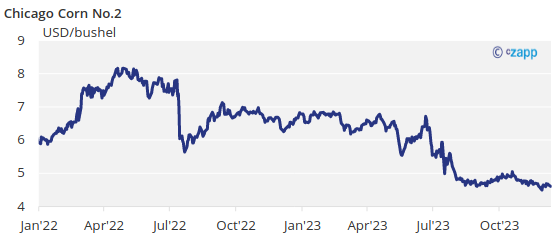Insight Focus
- Wheat rallies following aggressive Chinese buying.
- China’s poor wheat crop quality may be to blame.
- India may also seek wheat imports to tame food price inflation.
Forecast
No changes to our forecast for Chicago Corn in a range of 3,9 to 4,15 USD/bu for the average of the 23/24 (Sep/Aug) crop but with an upside bias. The average price since Sep 1 is running at 4,77 USD/bu.
Market Commentary
Small weekly gains in corn after a negative Friday offset most of the early weekly rally. The December WASDE was a non-event. Wheat rallied in the US on the back of strong exports.
Another strong start of the week and again on the back of short covering after the COT reported both US Corn and US Wheat were holding the largest net short of the last few years.
Buying was triggered by strong exports. By the end of the week, repositioning for the December WASDE occurred as well and Friday was a negative day for both Corn and Wheat, but mostly dragged down by Soybeans which saw higher stocks than expected after the WASDE was published.
Wheat rallied again last week and once more on the back of strong purchases of US Wheat by China as reported by the USDA. The aggressive buying by China appears to be caused by poor quality of their crop.
There is also talk in the market India will have to allow imports again trying to control their local prices to tame inflation, so there is expectation they will waive the 40% import tax.
The Dec WASDE reduced US Wheat ending stocks by 25 mill bu and like on the Corn side, all is coming from higher exports now projected at 725 mill bu vs. 700 before.
World Wheat stocks were reduced by 490k tonne in the latest WASDE, immaterial to the market. Production was revised higher by 1 mill tonne with Australia and Canada 1 mill tonne higher each, while Brazil 1 mill to lower. All other geographies were left unchanged or with marginal changes. The Ukrainian government increased their Wheat production forecast to 22,2 mill tonne also fully in line with the 22,5 mill tonne of the WASDE.
US Wheat area under drought conditions fell one point in the week to 37%. French Wheat is 89% planted vs. 99% last year, and conditions worsened to 77% good or excellent three pts lower week on week and vs. 97% last year. Argentinian Wheat is 48,2% harvested.

US Corn exports continued to support the market as well with weekly exports as of Nov 30 rallying +183% week on week and was the only highlight of the December WASDE published last Friday.
The Dec WASDE reduced US Corn ending stocks by 25 mill bu for the new crop, all coming from higher exports now of 2,1 bill bu vs. 2,075 before. All other items of the S&D balance were left unchanged.
World Corn ending stocks were marginally increased by 230k tonne, immaterial to the market. Production was increased by 1,28 mill tonne as a result of Russia and Ukraine producing 1 mill tonne more each at 17 mill tonne and 30,5 mill tonne, respectively. The rest of changes were marginal and the increasing production was mostly offset by higher consumption resulting in the mentioned immaterial increase to ending stocks. The Ukrainian government increased their Corn production forecast to 30,1 mill tonne fully in line with the WASDE projection.
In the US, Corn is virtually harvested and area under drought condition is now 43% or one point lower week on week. Ukrainian Corn is 87% harvested. In Brazil, the first Corn crop is 91% planted and the summer Corn crop is 60% planted vs. 71,2% last year. Argentinian Corn is 40,3% planted and condition improved a sizable 10 pts thanks to good rains and is now 36% good or excellent vs. just 18% last year.
BCR in Argentina left their Corn production forecast unchanged at 56 mill tonne (vs. 55 mill tonne of the WASDE) which is a massive +65% year on year given the drought hit crop of last year. Conab in Brazil reduced their Corn production forecast marginally to 118,5 mill tonne vs. 119,1 in November which is a big difference vs. the 129 mill tonne of the WASDE. Last year’s production was 131,9 mill tonne.

Trade flow out of the Black Sea continues to increase and is not only the Danube ports but also deep sea ports saw volumes as large as in river ports during November, as published by the Ukraine government.
In the weather front, rains are forecast in Brazil again in the center west while heat is expected in Argentina together with some rains. US weather is expected to be warm and dry which should help to complete Corn harvesting. Rains are expected in northern Europe.
As we suggested last week, Wheat condition in Europe is deteriorating while in the US is improving but European production is significantly bigger than US production and should weigh more in the market. The big picture is that global Wheat stocks are expected to fall by 10 mill tonne by the end of the 23/24 crop while Corn is expected to see a stock build of 15 mill tonne and soybeans smaller stock build of 12 mill ton.
Once more, only European Wheat is the most supportive element of the grains complex, while Corn and Soybean should have more downside than upside risk.
Small weekly gains after a negative Friday offset most of the early weekly rally. The December WASDE was a non event. Wheat rallied in the US on the back of strong exports. The big picture is that global Wheat stocks are expected to fall by 10 mill tonne by the end of the 23/24 crop while Corn is expected to see a stock build of 15 mill tonne and soybeans smaller stock build of 12 mill tonne. Only European Wheat is the most supportive element of the grains complex, while Corn and Soybean should have more downside than upside risk. No changes to our forecast for the new 23/24 crop for Chicago Corn in a range of 3,9 to 4,15 USD/bu but with an upside bias. The average price since Sep 1 is running at 4,77 USD/bu.













